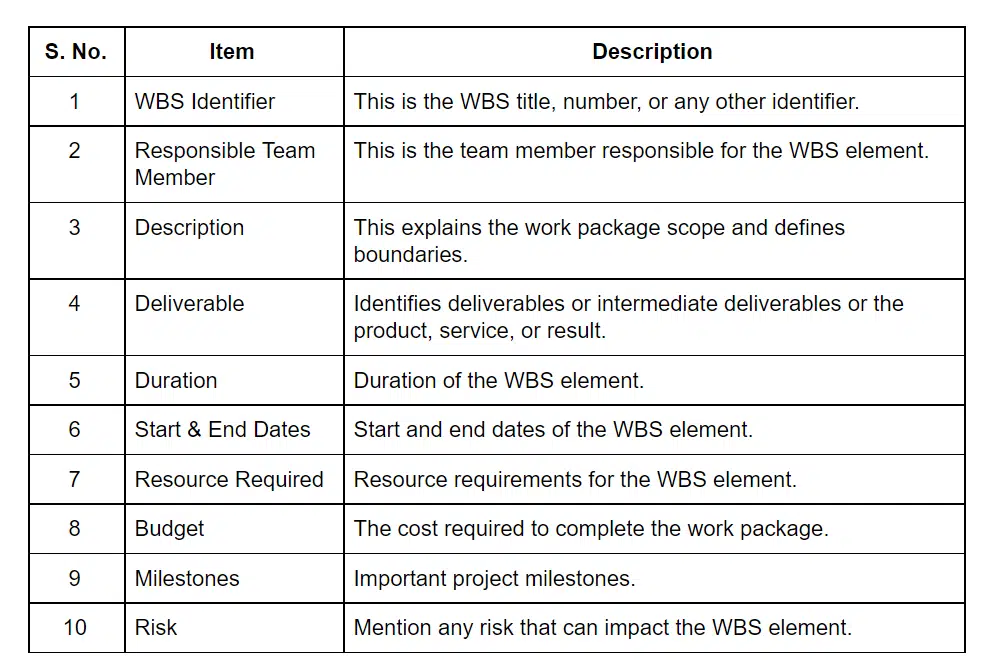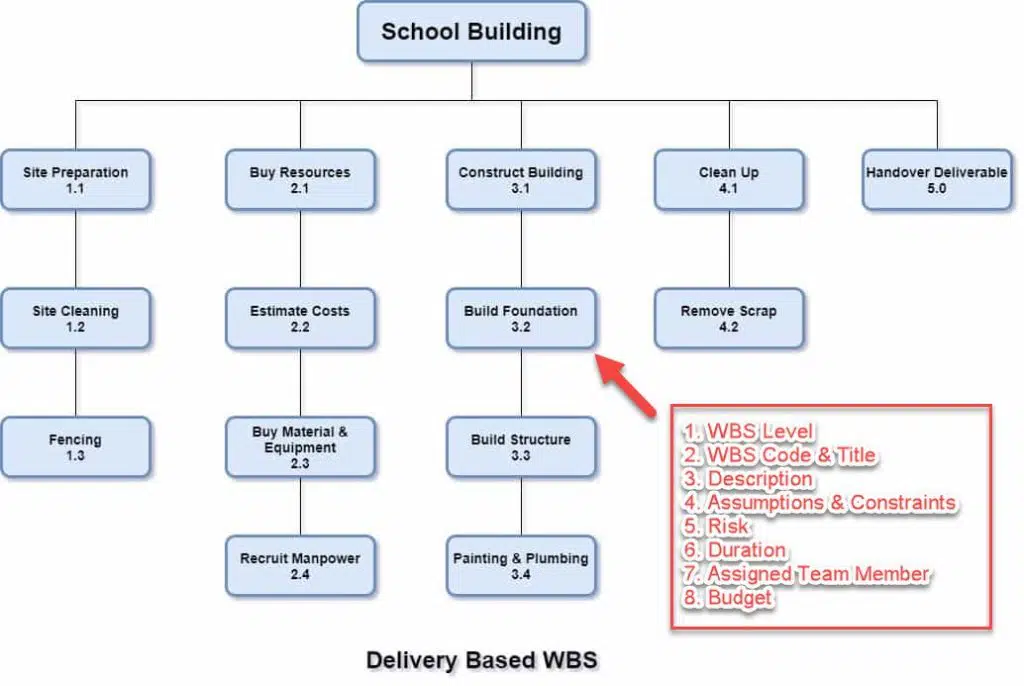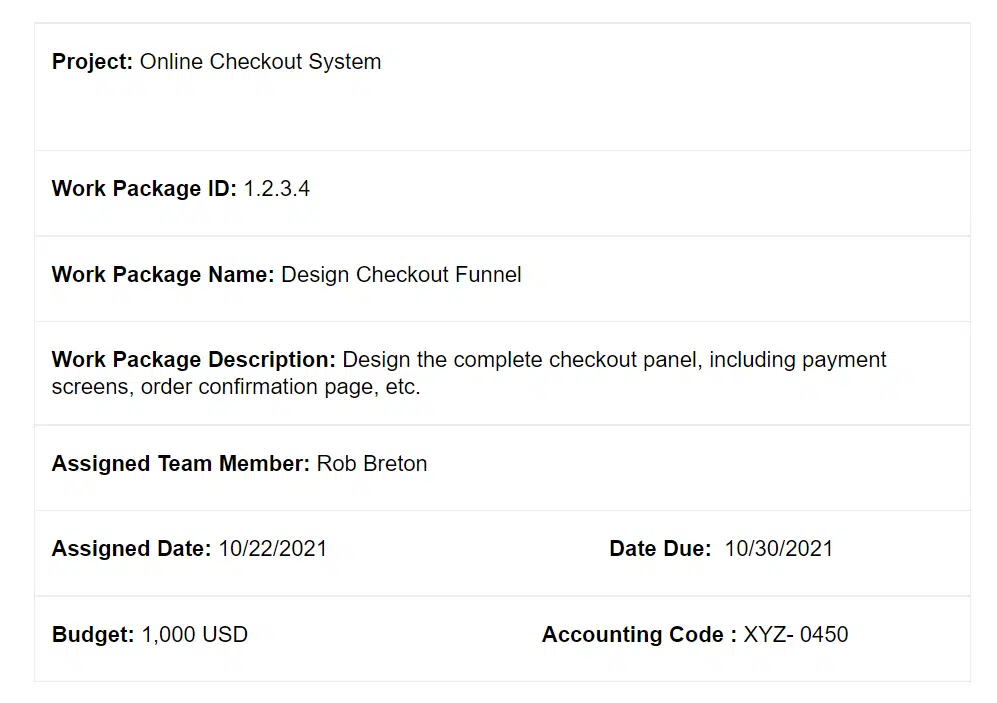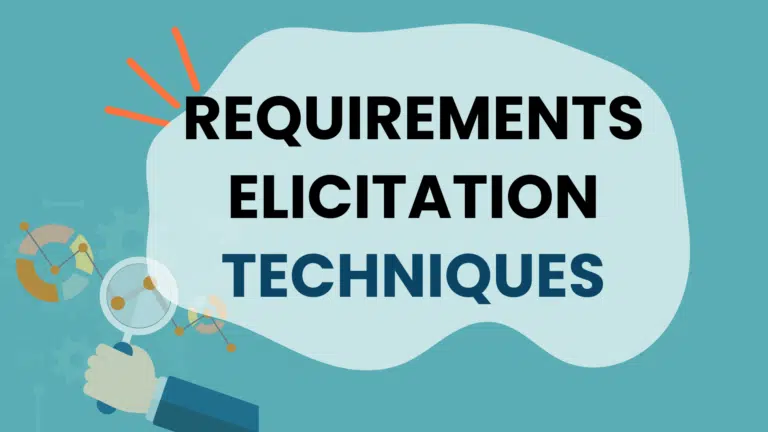Today, we will discuss WBS Dictionary, a vital project management document that complements the Work Breakdown Structure.
This is an important document; without it, you cannot monitor the scope performance.
WBS Dictionary is a part of the scope baseline. The scope baseline has three components; the other two components are the scope statement and WBS.
WBS Dictionary
According to the PMBOK Guide, WBS Dictionary is “A document that provides detailed deliverable, activity, and scheduling information about each component in the work breakdown structure.”
WBS Dictionary provides detailed information on each element of WBS, including deliverables, milestones, deliverables, scope, duration, start and end dates, required resources, costs, quality, assigned team members, etc.
The Objective of the WBS Dictionary?
WBS Dictionary is a good communication tool and helps stakeholders demystify the WBS and helps them understand WBS.
The second objective of the WBS Dictionary is to help avoid scope creep and gold plating by defining the scope of work. A clear work definition and transparent work assignment help avoid miscommunication, and team members will know what they are supposed to do.
No extra work will take place.
WBS Dictionary complements the WBS, which is a graphical representation of the scope of work. Being graphical, WBS does not explain the scope of work, so WBS Dictionary comes to the rescue. It adds additional information to WBS to make it complete and increase usability.
WBS Dictionary Template

The WBS must contain 100% of the scope of work, and you cannot show it using a graphical or tabular form. Therefore, WBS Dictionary explains the scope of work of each WBS element to ensure it covers all work.
Many experts call WBS Dictionary a work package description tool. They are also created hierarchically, like WBS, to explain the WBS element systematically.
How to Create WBS Dictionary

You develop WBS Dictionary after creating the Work Breakdown Structure. You start creating it from the top-level element and move downward until you reach the work package level. This approach ensures 100% scope of work at all levels.
While creating a WBS Dictionary, use the template given in the above table to ensure that your WBS dictionary is short and meaningful and does not repeat the scope of work. You provide brief information with an easy understanding of the work package.
Use the following steps to develop a WBS Dictionary:
#1. Review the WBS
Review the WBS to ensure that team members understand it, and it covers 100% of the scope of work, and there is no duplication. If any modification is required in the WBS, make necessary amendments.
#2. Create Top-Level Elements
Determine what type of ID you will use to identify your WBS element. Afterward, name the top-level element, add an identifier and describe it. You can include primary delivery, budget, duration, milestone, assumptions and constraints, and risks.
#3. Create Lower-Level Elements
Then, you can create the lower-level elements using the same template and verify that it covers 100% of the scope of work and is equal to the parent level. If any modification is required at the upper level, make changes.
#4. Create the Work Package
The work package is the last level of the WBS. Here, you can assign the person responsible and identify it as a control account. Finally, validate the 100% scope of work.
Best Practices for Creating WBS Dictionary
- The higher-level elements should have fewer details than the lower-level element.
- Use the standard template for developing a WBS Dictionary for each element for consistency.
- If you are using a project management tool or flowcharting software to develop WBS Dictionary, insert WBS Dictionary in the same place on the same document for easy referencing.
- If the scope of work changes, update WBS Dictionary.
Content of WBS Dictionary
A WBS Dictionary can have the following information:
- WBS Identifier: Each WBS element has a unique identity and title.
- Description: All elements must have well-defined boundaries, assumptions, constraints, scope, etc.
- Responsible Team Member: Each element should have a group or a team member assigned to it so you know who is responsible for completing the WBS element.
- Deliverable: Include the deliverable of the product service or result and any intermediate deliverable.
- Acceptance Criteria: Add customer acceptance criteria for the deliverable.
- Duration: Add the WBS element duration.
- Milestones: List all milestones and intermediate milestones and project management dependencies.
- Budget: Add the budget of the WBS element.
- Risks: Mention all risks affecting the WBS element.
WBS Dictionary Example
The following is an example of the WBS Dictionary:

A Few FAQs on WBS Dictionary
Why Do We Need a WBS Dictionary?
Being graphical, WBS does not provide enough information, and your project stakeholders may find it challenging to understand the communication. In such cases, the WBS Dictionary is very helpful, as it explains and provides complete information on each element of WBS.
What Tools Are Required to Create a WBS Dictionary?
Most organizations use Excel or Word software to create the WBS Dictionary. However, for larger projects and in a big organization, you will have access to project management tools such as monday.com, nTask, ClickUp, etc., that can help you quickly develop the WBS and WBS Dictionary.
Who Creates WBS Dictionary?
Creating a WBS Dictionary is not a one-person task; it requires teamwork. It is necessary for the team members with skills in project management to create the WBS Dictionary.
A combined effort ensures a sense of responsibility, and team members will be committed to it.
The project manager may also need the help of subject matter experts in creating the WBS Dictionary.
Summary
WBS Dictionary is the backbone of WBS. WBS is a skeleton, and WBS provides detailed information on WBS elements. It is the basis of preparing work authorization, estimating costs, developing schedules, and monitoring project tasks.
WBS has minimal information, but WBS Dictionary provides short and complete information to develop project management plans.
Here is where this post on WBS Dictionary ends. Please share your experience with the project management documents through the comments section.
Please note that WBS Dictionary is an essential concept from a PMP exam point of view.

I am Mohammad Fahad Usmani, B.E. PMP, PMI-RMP. I have been blogging on project management topics since 2011. To date, thousands of professionals have passed the PMP exam using my resources.







